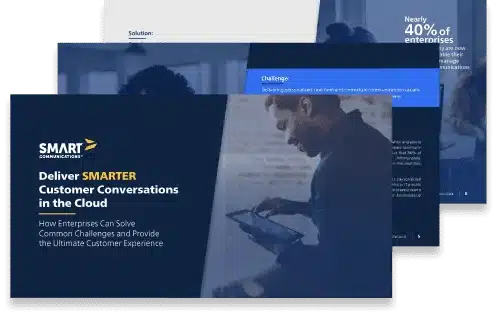Embracing the Future of Customer Communications Management Today
By Chris Murphy, Senior Director of Product Marketing at Smart Communications
The customer communications management (CCM) industry has been around for some time. Born out of a need for companies to be able to produce compliant, yet highly personalized communications, enterprises invested in platforms that allowed them to produce mission-critical business and customer communications at massive scale.
Yet, despite its extensive and tenured history and the disruption caused by industry consolidation, innovation is still alive in the CCM space. During a recent webinar, Craig LeClair, vice president and principal analyst of Forrester Research, painted a vision for where the industry is moving and where vendors who support customer communications will need to shift focus in order to realize success for the modern customer. With movement to the cloud, eDelivery promotion across digital channels, and customer experience improvements, the future of SMARTer customer communications is looking bright.
Communication Types Require Specialty Focus Areas
Craig adeptly broke down the types of customer communication management areas of focus, and the different business use cases that each are well-designed to meet.
- Structured offerings are largely on-premise and are ultimately designed to handle high-volume print outputs.
- Interactive offerings allow for deeper personalization and afford high-levels of business user control in order to customize the type, channel, and content of the communication.
- Cloud-based offerings, often delivered via hybrid-cloud or in a true multi-tenant fashion, signify a future where they can interact with cloud-based analytics services to gain an understanding of the customer’s true intent and to then seamlessly choose from an array of dynamic templates in order to deliver the right content.
Movement to the Cloud
One of the key trends mentioned in the webinar was the movement of CCM vendors to the cloud. This pivotal shift will allow CCM to begin to play a much more integrated role in the wider technology ecosystem and can be more easily informed by analytics from other technologies will be predominantly cloud-based in the future. The modern customer is not predictable, nor linear in the methods and channels that they engage with you through. The ability to consume information from these third-party analytics systems will allow CCM vendors to hone in on what the customer is ultimately trying to achieve, and how to get them there with hyper-focused communications. Ultimately CCM vendors will adopt a Communications-as-a-Service (CaaS) strategy, where a callable infrastructure is used to generate and initiate communications based on real-time customer actions as well as triggers from third-party systems.
Communication Trends are Changing………Toward the Customer
Communications trends are changing from a siloed, line-of-business run approach to one that is much more centralized and has the customer firmly in the center. There has been a movement from focusing on the template approach driven by systems of record to reimagining how these communications are received – and perceived – by the end customer.
With an emphasis on interactivity, responsiveness, engagement, and contextual understanding, the future of communications will be analytics-based and incorporate digital communications.
The Critical Impact of Language
“You say tomato, I say tomahto.” While we’re all familiar with the song, I think that we can agree that this approach just doesn’t work in print. Similarly, much of the language used in current communications often fails to articulate the core message we’re trying to portray to our customers and makes it difficult to understand the meaning, definitions and ultimately next steps. As a result of overly stringent legal input into the language used in these communications, what often ends up protecting the company can also end up confusing the end recipient. There is a growing trend to begin to use shared language libraries made up of definitions and shared content that is easily understood and leveraged across a variety of communications.
Key Areas to Look for When Building Next-Gen CCM
While everything should be driven by core business requirements, there is an energetic movement of CCM vendors to the cloud. As a result, Craig cautioned against falling into the trap of assuming managed services are the same as true cloud-based solutions.
In Craig’s words, “You want to look for a cloud-ready solution. You want something that has proven multi-tenancy, that has browser and thin-based clients, and a good set of APIs that can work to get to on-premise information. Look for an architecture that has a more generic type of format as core content to make it easy to switch from one channel to another.”
Future Innovations Driving CCM and Customer Experience Innovation
The growing interest in customer journey mapping and Design Thinking will firmly move the focus towards a customer-centric point of view and this will be the driver for the next generation of communications. The combination of core system data with a customer’s behavioral activity will represent the foundation of machine-readable content to which machine learning can be applied to analyze, learn and ultimately predict the most optimized communication, content and even channel to engage through.
As customer experience (CX) becomes a source of competitive advantage for more companies, customer communications – both the communications that you share with them as well as the opportunities that you provide for them to communicate with you – will continue to play a crucial role in the creation of those experiences.
To listen to a complimentary recording of this webinar, please visit the following page.



